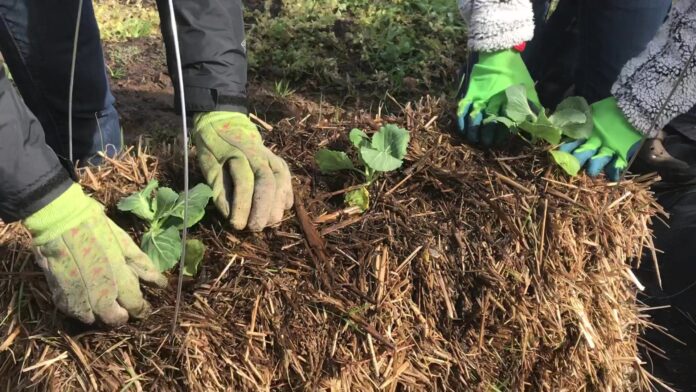AUBURN UNIVERSITY, Ala. – Farmers and gardeners have been using compost for thousands of years, but that doesn’t mean it always has to be the same old food scraps, pet scat and lawn clippings. Wheat straw bales make great compost—and great planters.
What is straw bale gardening?
“Straw bale gardening is simply planting vegetables into a straw bale that has been conditioned or gone through a composting phase,” said Dani Carroll, an Alabama Cooperative Extension System home grounds, gardens and home pests regional agent. “It is great for urban areas and homeowners with a smaller plot.”
Benefits of Straw Bale Gardening
Carroll recommends this type of gardening for anyone interested, but particularly for people who have difficulty handling tools like shovels or trowels. Urban areas often lack good soil or space. Straw bales are a great way to take advantage of what space is available. They also contain great nutrients for plants, when properly conditioned. Carroll recommends only certain types of plants.
“I like to grow herbs, flowers and traditional vegetables,” she said. “Shorter plants like tomatoes, broccoli, cabbage and greens tend to work best. Taller, larger or heavier plants could knock the bale off balance, catch too much wind or simply be too large to plant in a single bale.”
Transplants are the planting method of choice, as seeds are more difficult to germinate using this method.
Straw Bale Preparation
To begin, gardeners should buy a wheat straw bale. According to Carroll, wheat straw works best because pine straw does not break down enough and hay bales may contain more weed seeds.
The gardener should then saturate the bale with water before adding fertilizer. They should use high nitrogen, water soluble fertilizer. The gardener should thoroughly re-water the bale each time they fertilize.
On day 10, the gardener should add one cup of dolomitic lime over the top of the bale, and water it. Afterwards, they should add some balanced fertilizer for several days until the conditioning (or composting, whichever you prefer) process is finished. The process should take about two weeks.
Planting a Straw Bale
Once conditioning is complete, the gardener should plant the garden as they would any other garden. Carroll also recommends backfilling the hole around the plant once it is in place to fill any gaps and help the root system grow.
The gardener can then maintain the straw bale garden as if it were a basic, on-the-ground garden. They should make sure to water regularly until finished with the bale.
The Alabama Cooperative Extension System’s Straw Bale Gardening Guide suggests recycling bales after they are depleted. They make great mulch or compost. The guide also adds that you may be able to get two plantings out of one straw bale.


























